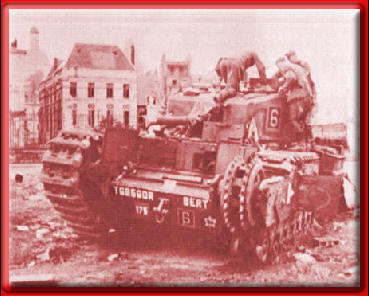
The Dieppe Raid
August 19, 1942

Germans Examining at Captured Churchill Tank at Dieppe
Operation Jubilee, as it came to be known, started with a memo from the Allies' invasion planning group to the operations staff headed by Lord Mountbatten:
|
Please raid one of these ports in sufficient strength to persuade the enemy to react as if he were faced with actual invasion.
|
On the morning of the assault, August 19, 1942, surprise was lost by the chance meeting of the invasion ships and a coastal convoy. On the flanks some of the commando efforts were effective, but on the highlands west of Dieppe proper, the South Saskatchewan Regiment got bogged down and at Puys to the east, the Royal Regiment of Canada was destroyed taking 94.5% casualties.

More Carnage at Dieppe
Nevertheless, there is hardly a book written on the Normandy Invasion that does not give great credit to the Dieppe Raid. The plan for Overlord, the invasion on June 6, 1944, was certainly different. It featured an assault against open beaches rather than in front of a fortified city. Surprise and command of the air were total that day. Most importantly, the initial assault was overwhelming in numbers, firepower and logistics. For D-Day, it seems Dieppe provided the chart on how NOT to do it.
For some additional information on Dieppe visit:
Naval Staff History: Dieppe
